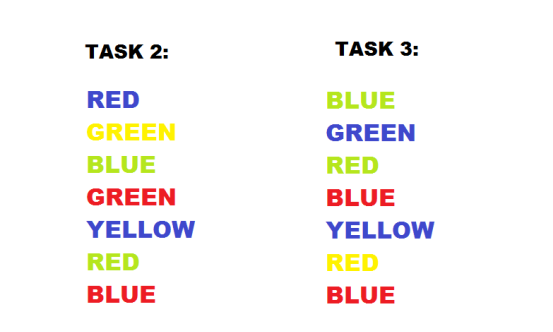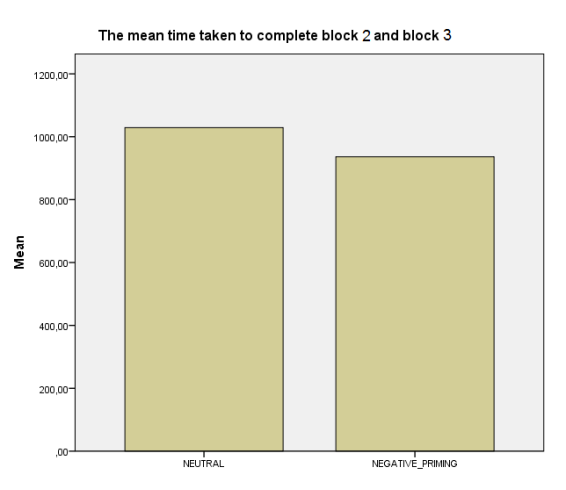Inhibitory processes in selective attention: how negative priming affects reaction time
Abstract
To date, many research delineated potential evidence that prove the presence of an interference in the response time to a stimulus that was before inhibited in order to focus on precise information.
In the experiment a within-subjects design was used. The performance of these participants was evaluated in a computerised task based on Stroop colour-word test, which was divided in three blocks.
Using the results from this study we were able to conclude that that no decrease in reaction time arosed when participants were exposed to negative priming condition. This finding did not support the proposed hypothesis and previous research. Nonetheless, this reversed direction may be caused by the practice effect, which occurs when test is taken more than once.
In order to gain a deeper insight of the meaning of the results, this type of research needs to be replicated with proper corrections.
Introduction
In everyday life a wide variety of stimuli are presented in the surrounding environment, but in order to accomplish objectives an individual needs to focus on a precise amount of information, to the detriment of others (Tipper, 1985). For instance, amongst an assortment of pens, each of them of a different colour, one must inhibit the image of the whole pen case in order to not lose focus on a specific object desired. This process is called negative priming (NP) and correspond to, as suggested by Tipper (1985), the decelerated response to a stimulus that was before suppressed. The purpose of this research is to investigate the decrease in reaction time when negative priming effect occurs.
At present, there are many studies which provide scientific evidence to support this hypothesis.
One of the first researcher to examine this theory was Stroop (1935), who developed a colour word task, similar to the one used in this experiment, to verify interferences between conflicting processes.
Dalrymple-Alford and Budayr (1966) indicated that interference in the list form of the Stroop task was higher if each colour was that mentioned by the preceding word. Neill (1977) widened their study to the trial version of the Stroop test, finding that there is a higher interference if the word on task N corresponded with the ink colour on task N +1. He named this phenomenon the distractor-suppression effect.
Fifty-four undergraduate students from Kingston University were recruited via seminar registers. Neither age nor gender were taken into consideration.
Design
To carry out the experiment, a within-subjects design is applied, as every participant is exposed to all conditions. The dependent variable is reaction time, whereas the independent variable is negative priming.
Materials
The study was directed in a computer room at Kingston University on a screen with a connected keyboard. The test could be found online on PsyToolkit.org. At the end of the experiment, the seminar took note of the results of each participant on paper which were later analysed on SPSS.
Procedure
The research was held during regular seminars at university in a computer room, where participants were given oral and written directions from the seminar tutor. Prior to the beginning, they were asked to fill out a consent form. Subsequently, the students sat in front of a PC quietly for one minute. Later, they were given a link to access the Stroop color word test on the following website: psytoolkit.org.
The task had three blocks to complete. In the first block, students were provided with an opportunity to familiarise with the buttons required to complete the task.
Get Help With Your Essay
If you need assistance with writing your essay, our professional essay writing service is here to help!
The other blocks tested the neutral (block 2) and the negative priming conditions (block 3). In these tasks, participants were showed different colour names (red, green, yellow and blue) written with an ink which most of the time did not match with the word. For instance, if the word showed on the screen is “green”, as the colour is red, the button to be pressed would be “r” (red).

Figure 1.0 Tasks instructions
As shown on Figure 1.0, the other letters on the keyboard used for the experiment were “g”, “b” and “y”, for green, blue and yellow. The difference between the second and third part of the test is that, while there is no negative priming between words in block 2, block 3 presents a correlation between the current word and the preceding word. For instance, consider Task 3 in Figure 2.0 below. The word “blue” is green, but the next word “green” is written in blue, which means there is an association between the suppressed color word and the ink color in the subsequent example.
At the end of the third block, participants were given their results.

Figure 2.0 Illustration of negative priming. Task 2 shows the control condition; task 3 shows the negative priming condition
Results
The reaction times in both conditions were analysed using a paired samples t-test. As shown in Figure 2.0, the mean response time in neutral condition (M=1029.05, SD=187.04)Â was meaningfully slower compared to the mean response time in negative priming condition (M=936.00, SD=182.76)( t(53)=5.659, p<.001). The t-test indicated that the Sig. (2 tailed) value was significant.
These findings suggest that the hypothesis that reaction time in adults decreases when responding to an object that had to be ignored before may be inconsistent. 
Figure 3.0 Illustration of the difference between neutral condition mean and negative priming condition mean
Discussion
In summary, this experiment has raised the following point. Reaction time in neutral condition is lower compared to reaction time in negative priming condition, finding which does not support the hypothesis.
One weakness of this research is the possible presence of confounding variables. In the consent form it is stated that applicants are “healthy adults”. However, uncertainty may be expressed regarding the definition of “healthy” and the way health has been measured. Some participants may possess distinctive skills such as enhanced visual-spatial abilities and, consequently, may have an advantage over the assignments. Nevertheless, participants may also have health conditions which could hinder their results. For instance, they may suffer from disorders which cause slower reaction time. To prevent this in future experiments, one may conduct health questionnaires to ensure all applicants are suitable for this study.
Another variable that has to be taken into consideration is the possibility of an alteration of data due to test taken by groups during different times of the day and the age of participants. In fact, a study conducted by Pope (2016) shows that students are more productive in the morning than in the afternoon.
Lastly, practice effect may have affected the results, as in the experiment task 2 (neutral condition) and task 3 (negative priming condition) had the same type of procedure. This would explain why the data had a reversed direction, whereas previous studies on negative priming conducted by Tipper (1985) and Dalrymple-Alford and Budayr (1966) had different outcomes. To remove the order effect, a counterbalanced design should be applied to separate groups, each of those carrying out the test in a different order but at the same time.
Find Out How UKEssays.com Can Help You!
Our academic experts are ready and waiting to assist with any writing project you may have. From simple essay plans, through to full dissertations, you can guarantee we have a service perfectly matched to your needs.
View our academic writing services
Overall, the data unexpectedly showed a higher delay in response time under neutral condition, meaning that there is a disagreement between the hypothesis and the experimental data, even though previous studies support it. Furthermore, no particular theoretical significance has been discovered, as there is a difference of only a tenth of a second between response speed in neutral condition and in negative priming condition. Further work is required to confirm the validity of these results.
References
Dalrymple-Alford, E.C. & Budayr, B. (1966). Examination of some aspects of the Stroop color word test. Perceptual & Motor Skills, 23, 1211-1214.
Neill, W T. (1977). Inhibitory and facilitatory processes in selective attention. Journal of Experimental Psychology: Human Perception and Performance, 3, 444-450
Pope, N. G. (2016). How the time of day affects productivity: evidence from school schedules. Review of Economics and Statistics, 98(1), 1-11. doi:10.1162/rest_a_00525
Stroop, J. R. (1935). Studies of interference in serial verbal reactions. Journal of Experimental Psychology, 18, 643-662
Tipper, S.P. (1985). The negative priming effect: inhibitory priming by ignored objects. Quarterly Journal of Experimental Psychology: Human Experimental Psychology, 37A, 571-590.
Cite This Work
To export a reference to this article please select a referencing style below:


